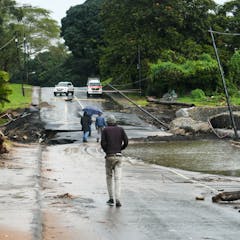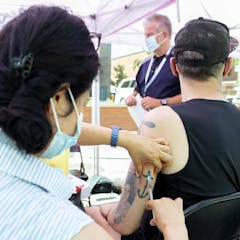
Articles on Infectious diseases
Displaying 81 - 100 of 484 articles

The evidence so far suggests this wave could be a shorter and smaller version of the Omicron BA.5 wave.

Cases of scarlet fever have bounced back with a vengeance now that COVID measures have been lifted.

Hunters are warned to take precautions handling wild birds, and the virus can spill over to non-avian species, so no one should approach wild animals that appear ill.

Natural disasters associated with climate change put people at risk of injury and death, and alter the prevalence and distribution of illnesses and infectious diseases.

We’ve learned much from large COVID outbreaks linked to the Ruby Princess and Diamond Princess cruise ships early in the pandemic. But there’s still some way to go.

Bits of viral genes incorporated into human DNA have been linked to cancer, ALS and schizophrenia. But many of these genes may not be harmful, and could even protect against infectious disease.

On World Rabies Day – which is also the anniversary of French microbiologist Louis Pasteur’s death – a virologist reflects on the achievements of this visionary scientist.

The pandemic has disrupted national immunisation programmes. As a result, the African continent is seeing more outbreaks of vaccine preventable diseases.

Evidence is growing there are changes to your immune system that may put you at risk of other infectious diseases.

The CDC’s endorsement of the reformulated COVID-19 booster shots represents a major step in the effort to get more Americans boosted.

Swabs from two children in the UK reveal the cause of the ‘mysterious illness’.

Polio cases in the US, UK and Israel remind us that this could also happen in Australia. Here’s what we should watch out for.

If surveillance focuses only on diseases that have already emerged, we’ll remain behind the curve. Better prediction of future pandemics will need to integrate animal, planetary and human health.

The virus is related to Hendra and Nipah viruses. But we don’t know whether it spreads from human to human.

There are no known cases of women infected with monkeypox during pregnancy within Australia to date, but there are such cases in the UK and US.

It’s not just mosquitos. Flooding, extreme heat and other climate-related hazards are bringing people into contact with pathogens more often, and affecting people’s ability to fight off disease.

While the majority of monkeypox cases thus far have been recorded among men who have sex with men, everyone is still at risk of contracting the disease.

Declaring monkeypox a national health emergency will allow the U.S. government to direct resources and funds where needed to help slow the spread of the virus.

Infectious diseases originating in wild animals are high and may be increasing. This is a sign that ecosystem degradation is undermining the planet’s capacity to sustain human wellbeing.

To control monkeypox, there is a short window — weeks, not months — in which to vaccinate the most susceptible and to encourage and support self-isolation for those who have symptoms.
